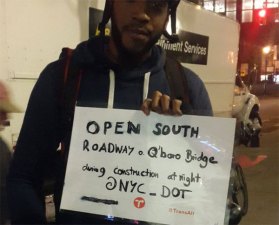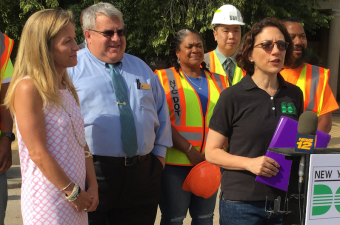Queensboro Bridge Bike/Ped Path Will Close Every Night Until 2017 (At Least)
Valentin wants to sleep, not take bus home. He wld be grateful for South access to QBB at night @NYC_DOT @transalt pic.twitter.com/TiHO8Kvcvj
— Angela Stach (@radlerkoenigin) April 28, 2016
People who bike over the Queensboro Bridge had to endure months without nighttime access to the bridge’s car-free path earlier this year, with ConEd infrastructure work closing off the north outer roadway. Now, after a short respite, ConEd work has resumed, and nightly closures are slated to last “through the end of the year,” according to DOT’s Facebook page for the bridge.
The Queensboro path carries thousands of cyclists across the East River each day, but will be closed seven nights a week between 9 p.m. and 5 a.m. Previous closures this year started at 10 p.m. The people most affected are working cyclists on their way to work or home.
In the spring, when the closures began, activists from Transportation Alternatives’ Queens committee called on DOT to open bike access at night to the unused south outer roadway. The city didn’t act on the idea. Instead, cyclists who need to get across the river can take a shuttle bus provided by ConEd every 15 minutes, or find another way home.

Finding another way home seems to be the preferred alternative, according to one anonymous tipster. “Cyclists were surprised [by the closure] and were turning away to go to the [Triborough] Bridge or the Williamsburg Bridge,” she said. “Few choose the shuttle.”
With infrequent service and pick-up and drop-off points far from the path’s entrances, the shuttle bus is just not a viable alternative for people who bike or walk, say commenters on DOT’s most recent Facebook update. “The shuttle service is not an adequate solution for pedestrians and especially cyclists, for whom it takes about 4 times as long to get over the bridge compared to riding,” wrote Sarah Acheson.
“ConEd and NYC DOT should have thought of a better plan for us cyclist[s] and pedestrians after all we also are fathers and mothers that work,” said Eking Vilora. “Shuttles are great but with the traffic crossing this bridge [are] definitely not an answer for us! [Wake] up and give us some room for a normal commute home.”
DOT closed the south outer roadway at night toward the end of 2013, following a string of fatal crashes involving drivers using that lane. Streetsblog asked DOT in April if it would consider opening the south outer roadway to cyclists and pedestrians at night, and the agency did not respond.
Making the south outer roadway a permanently car-free path would provide some redundancy in the event the north outer roadway has to be closed. The north outer roadway is already cramped with biking and walking traffic at peak hours, and claiming a path on the southern side for active transportation would relieve the pressure.

